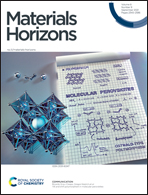Tilt and shift polymorphism in molecular perovskites†
Abstract
Molecular perovskites, i.e. ABX3 coordination polymers with a perovskite structure, are a chemically diverse material platform for studying fundamental and applied materials properties such as barocalorics and improper ferroelectrics. Compared to inorganic perovskites, the use of molecular ions on the A- and X-site of molecular perovskites leads to new geometric and structural degrees of freedom. In this work we introduce the concept of tilt and shift polymorphism, categorising irreversible perovskite-to-perovskite phase transitions in molecular perovskites. As a model example we study the new molecular perovskite series [(nPr)3(CH3)N]M(C2N3)3 with M = Mn2+, Co2+, Ni2+, and nPr = n-propyl, where different polymorphs crystallise in the perovskite structure but with different tilt systems depending on the synthetic conditions. Tilt and shift polymorphism is a direct ramification of the use of molecular building units in molecular perovskites and as such is unknown for inorganic perovskites. Given the role of polymorphism in materials science, medicine and mineralogy, and more generally the relation between physicochemical properties and structure, the concept introduced herein represents an important step in classifying the crystal chemistry of molecular perovskites and in maturing the field.



 Please wait while we load your content...
Please wait while we load your content...